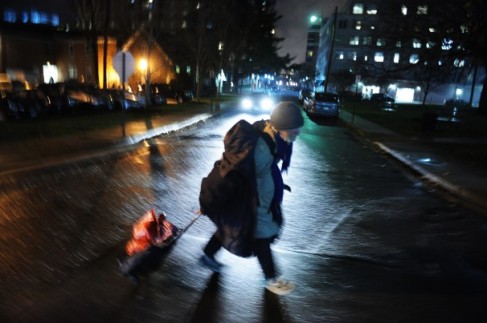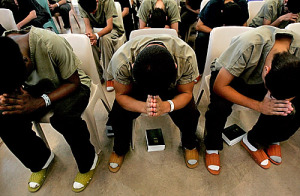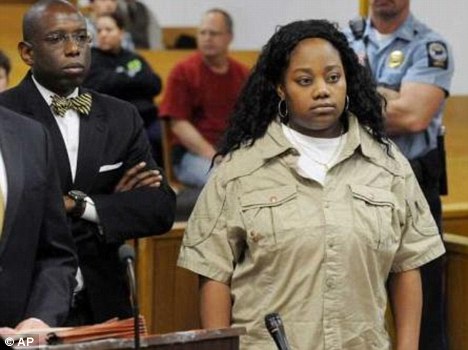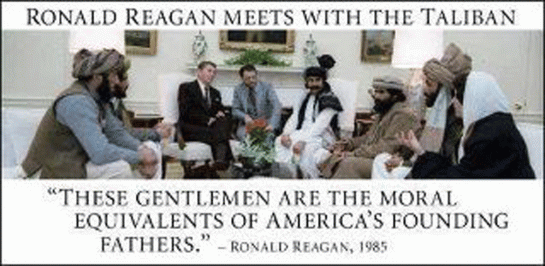
Ronald Reagan Meets with the Taliban
“These Gentlemen are the Moral Equivalents Of America’s Founding Fathers.” – Ronald Reagan 1985
President Reagan, as President was the country’s most notorious drug trafficker history has ever known–More than One Generation of American Citizens having resultantly been destroyed by his election and subsequent Presidency
SAM SMITH The nausea-inducing elevation of Reagan into someone he never was is another triumph of rightwing spin being swallowed whole by a media that not only doesn’t know the facts, it doesn’t even think it has to, for it, too, has become just another part of show business.
Guns haven’t made us safer: TrickleDown hasn’t made us richer; Global warming is real; Fair taxes/reasonable regulation aren’t Socialism Patrick Jennings @PatJennings
JUAN COLE – I remember seeing a tape of Reagan speaking in California from that era. He said that he had heard that some asserted there was hunger in America. He said it sarcastically. He said, “Sure there is; they’re dieting!” or words to that effect
GLENN KESSLER WASHINGTON POST – Reagan’s spending cuts barely nicked the fastest-growing parts of government, his tax cuts reduced revenue so much that later in his tenure taxes had to be raised repeatedly, his regulatory approach was criticized for leading to the savings and loan crisis and his unbalanced budgets to a near-tripling of the federal debt in eight years.
PHIL GASPER, COUNTERPUNCH – Reagan refused to mention AIDS publicly for six years, under-funded federal programs dealing with the disease and, according to his authorized biography, said, “Maybe the Lord brought down this plague,” because “illicit sex is against the Ten Commandments.”
TOM CARSON, VILLAGE VOICE – Ronald Reagan is the man who destroyed America’s sense of reality – a paltry target, all in all, given our predilections. It only took an actor: the real successor to John Wilkes Booth. In our bones, we had always been this sort of bullshit-craving country anyhow, founded on abstractions:
“For many Americans, this was a time best forgotten,” said Julian Bond, chairman of the NAACP and a longtime civil rights activist. “He was a polarizing figure in black America. He was hostile to the generally accepted remedies for discrimination. His appointments were of people as equally hostile. I can’t think of any Reagan policy that NEGUS’ would embrace.”
The former actor and California governor offended blacks when he kicked off his 1980 general election campaign by promoting “states rights” —  once southern code for segregation — in Philadelphia, Miss., scene of the murder of three civil rights workers 16 years before. Early in his first term, Reagan ordered some of his toughest budget cuts in Medicaid, food stamps, aid to families with dependent children and other “means tested” programs that were critical to large numbers of lower-income black families. Until a public protest forced Reagan to back away, his Agriculture Department sought to cut the school lunch program and redefine ketchup and relish as vegetables.
once southern code for segregation — in Philadelphia, Miss., scene of the murder of three civil rights workers 16 years before. Early in his first term, Reagan ordered some of his toughest budget cuts in Medicaid, food stamps, aid to families with dependent children and other “means tested” programs that were critical to large numbers of lower-income black families. Until a public protest forced Reagan to back away, his Agriculture Department sought to cut the school lunch program and redefine ketchup and relish as vegetables.
JOE STRUPP, EDITOR & PUBLISHER – The death of Ronald Reagan has become yet another reminder that news organizations often turn sentimental at the death of a former leader, no matter what legacy he or she leaves behind. . .The overwhelming praise for a president who plunged the nation into its worst deficit ever, ignored and cut public money for the poor, while also ignoring the AIDS crisis, is a bit tough to take. During my years at Brooklyn College, between 1984 and 1988, countless classmates had to drop out or find other ways to pay for school because of Reagan’s policies, which included slashing federal grants for poor students and cutting survivor benefits for families of the disabled.Not to mention the Iran-contra scandal, failed ‘supply-side economics,’ the ludicrous invasion of Grenada, 241 dead Marines in Lebanon, and a costly military buildup that kept us closer to nuclear war than at any time since the Cuban Missile Crisis, besides leaving us billions of dollars in debt. And should we even mention the many senior Reagan officials, including ex-White House aide Michael Deaver and national security adviser Robert McFarlane, convicted of various offenses? What about Defense Secretary Caspar Weinberger indicted but later pardoned by the first President Bush? “It is clear that each US government agency which had a relationship with Noriega turned a blind eye to his corruption and drug dealing,
In 1970 he had written a paper in which he called for martial law in case of a national uprising by black militants. Among his ideas were “assembly centers or relocation camps” for at least 21 million “American Negroes.” Those words come from a time when Giuffrida was the head of then-Governor Reagan’s California Specialized Training Institute, a National Guard school.
“This is an operation, this is an exercise, this is an objective which is going forward because in the long run . . . it is the only way that will be able to prevail [against anti-war protests.]”
Addressing the kickoff of Cable Splicer, Governor Reagan told some 500 military and police officers:
“You know, there are people in the state who, if they could see this gathering right now and my presence here, would decide their worst fears and convictions had been realized — I was planning a military takeover.”
General Anastasio Somoza, of the rightist regime, invited Sandino to meet in Managua for peace talks. Sandino agreed, and upon his arrival Somoza summarily seized and executed the man. The revolution was finally subdued, and in 1937 Somoza became dictator. From 1937 to 1979, Nicaragua was ruled autocratically by two successive generations of the Somoza family. On August 22, 1978, twenty-four Sandinista guerillas stormed the national palace at Managua, and by July 17, 1979, the Sandinistas had formally taken power. The Sandinistas quickly wrote and passed a provisional constitution, The Fundamental Law of State. This constitution guaranteed human rights that were previously ignored by the Somoza regime. It guaranteed equal justice under law, the right to free expression, and the abolition of torture. It seemed that the people were already benefiting from this great revolution, which truly did liberate them.
With the discrete help of the US, these so-called counter-revolutionaries, or contras, began a guerilla war on the Sandinistas. Despite the irony of this switch in positions, the contras, indeed, became guerillas (revolutionist; terrorist.) right after the Sandinista guerillas had ousted them from power. Though the Reagan administration was officially forbidden by congress to support the contras, the US secretly provided financial aid for them. Through Ollie North and the highly controversial Iran-Contra Affair, the US provided the contras with endless financial aid stemming from profits from an illegal arms trade with Iran.
Democratic Anti-Contra-War Campaign The socialist oriented Left had a natural affinity with the Leftist Sandinista Revolution. Reagan administration officials illegally sold arms to Iran and used the profits to illegally supply arms to the Contras The conference issued a statement declaring that “the United States government bears a direct responsibility for the long suffering of the Nicaraguan people”
“Once you set up a covert operation to supply arms and money, it’s very difficult to separate it from the kind of people who are involved in other forms of trade, and especially drugs. There is a limited number of planes, pilots and landing strips. By developing a system for supply of the Contras, the US built a road for drug supply into the US.”“Former CIA agent David MacMichael
In 1984, U.S. officials began receiving reports of Contra cocaine trafficking. Three officials told journalists that they considered these reports “reliable.” Former Panamanian deputy health minister Dr. Hugo Spadafora, who had fought with the Contra army, outlined charges of cocaine trafficking to a prominent Panamanian official and was later found murdered. The charges linked the Contra trafficking to Sebastián González Mendiola, who was charged with cocaine trafficking on November 26, 1984, in Costa Rica.
Reagan Administration admits Contra-cocaine connections
On April 17, 1986, the Reagan Administration released a three page report acknowledging that there were some Contra-cocaine connections in 1984 and 1985, arguing that these connections occurred at a time when the rebels were “particularly hard pressed for financial support” because U.S. aid had been cut off. The report admitted that “We have evidence of a limited number of incidents in which known drug traffickers have tried to establish connections with Nicaraguan resistance groups.” The report tried to downplay the drug activity, claiming that it took place “without the authorization of resistance leaders.”[8]
Kerry Committee
In 1986, Senator John Kerry and Senator Christopher Dodd proposed a series of hearings at the Senate Foreign Relations Committee regarding charges of Contra involvement in drug trafficking; the hearings were conducted by Senator Richard G. Lugar of Indiana, the Republican Chairman of the Committee. The report of the Committee, released on April 13, 1989, found that “Contra drug links included… payments to drug traffickers by the U.S. State Department of funds authorized by the Congress for humanitarian assistance to the Contras, in some cases after the traffickers had been indicted by federal law enforcement agencies on drug charges, in others while traffickers were under active investigation by these same agencies.” The U.S. State Department paid over $806,000 to known drug traffickers to carry humanitarian assistance to the Contras.[9]
Gary Webb[edit]
Former DEA agent Celerino Castillo alleged that during the 1980s Ilopango Airport in El Salvador was used by Contras for drug smuggling flights with the knowledge and complicity of the CIA. These allegations were part of an investigation by the United States Department of Justice Office of the Inspector General.[10] Castillo also testified before the House Permanent Select Committee on Intelligence. Between 1996 and 1998 the Central Intelligence Agency investigated and then published a report about its alleged involvement in cocaine sales in the US. This was prompted by the journalist Gary Webb‘s report[11] in the San Jose Mercury News alleging that the CIA was behind the 1980s crack epidemic. Gary Webb alleged through his Dark Alliance series that the government had been complicit in the trade of drugs in the inner city through the use of a kingpin named Freeway Ricky Ross. According to the Oakland Tribune, “In the course of his rise, prosecutors estimate that Ross exported several tons of cocaine to New York, Ohio, Pennsylvania and elsewhere, and made more than $600 million in the process.”[12][13][14]
- ‘Powerful reminder’: Ted Cruz flashes back to Ronald Reagan’s 1985 Thanksgiving address (twitchy.com)
- Watch: Ronald Reagan Delivers Stirring Radio Address to the Nation on Thanksgiving in 1986 (ijreview.com)
- ‘No Ronald Reagan on the scene today’ (wnd.com)
- Who Killed the Kennedys? Ronald Reagan’s Answer… (thecentralkentuckypatriot.wordpress.com)
- Maher: Reagan was a ‘square in a cowboy hat who had sex with a woman he called Mommy’ (rawstory.com)
- Art Imitates Life, Life Imitates Art – Brooklyn Cowboy or Lone Deranger? You Decide! Part 1 (poxamerikana.wordpress.com)
- Ronald Reagan’s Message To The GOP (themoderatevoice.com)
The Naval Versions of Reagan, Clinton, and Obama (sago.com)
- Who Killed the Kennedys? Ronald Reagan’s Answer… (thecentralkentuckypatriot.wordpress.com)
- Maher: Reagan was a ‘square in a cowboy hat who had sex with a woman he called Mommy’ (rawstory.com)
- Art Imitates Life, Life Imitates Art – Brooklyn Cowboy or Lone Deranger? You Decide! Part 1 (poxamerikana.wordpress.com)
- Ronald Reagan’s Message To The GOP (themoderatevoice.com)
The Naval Versions of Reagan, Clinton, and Obama (sago.com)
- Obama-contra (freebeacon.com)
- Crime History, Nov. 21, 1986: Oliver North, Fawn Hall begin shredding Iran-Contra evidence (dccrimestories.com)
- The Long Shadow Of Iran Contra (esquire.com)
- Obama’s Iran-Contra Moment (dish.andrewsullivan.com)
- NYC Mayoral Candidate De Blasio supported suppressing internal dissent, clamping down on a free press, antisemitism and persecuting the church and labor unions (atlasshrugs2000.typepad.com)
- President Ronald Reagan and the Real October Surprise (johnhively.wordpress.com)
- “We the People (or the 1%)” Bringing In Blacks with No Constitution – Skin Colour and the Constitution (ustaxpayerswill.com)
- Burke, Paine, and Reagan (nationalreview.com)
- Reagan’s Press Secretary Repeatedly Laughed At AIDS (bilerico.com)
Related articles
- Fight the right-washing of Nelson Mandela’s legacy (salon.com)
- Fox News Slimes Mandela: “A Great Man…But A Communist.” (jeffwinbush.com)
- Mandela was on US terrorist watch list till 2008 (alethonews.wordpress.com)
- Brian Dooley: Mandela, The United States, And Bahrain (huffingtonpost.com)
- Ronald Reagan’s Shining City Of Exceptional Immigrants (forbes.com)
- Reagan’s Press Secretary Repeatedly Laughed At AIDS (bilerico.com)
- Maher: Reagan was a ‘square in a cowboy hat who had sex with a woman he called Mommy’ (rawstory.com)
- Of course Rick Santorum is now comparing Obamacare to Apartheid (deathandtaxesmag.com)
- weird things I learned today about Nelson Mandela (busblog.tonypierce.com)



































































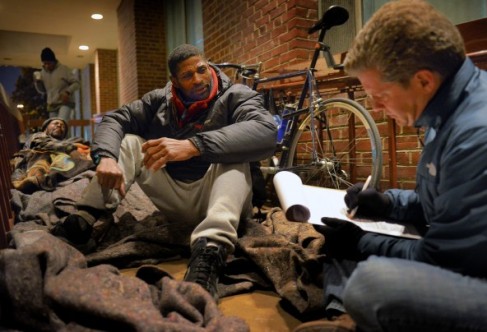
 New Directions helps homeless veterans reintegrate into civilian life.
New Directions helps homeless veterans reintegrate into civilian life.